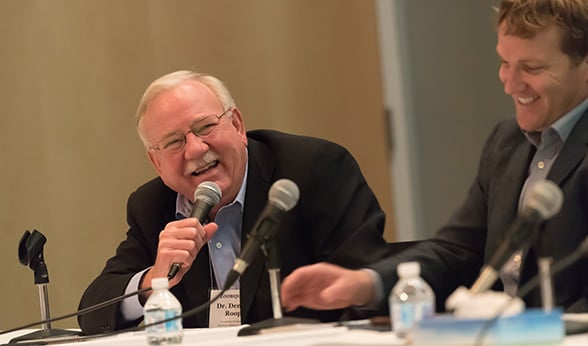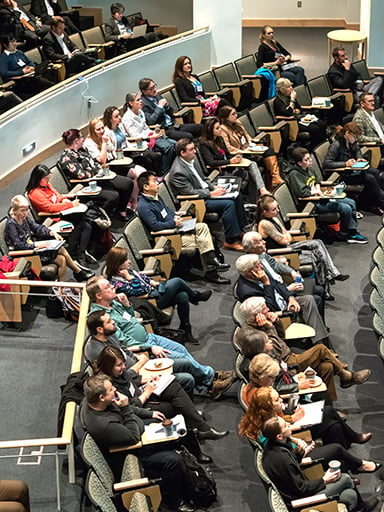The pace of progress in cell-based therapies and regenerative medicine is unprecedented, and the development of disease therapies, and possibly cures, will only accelerate in the near future.
That was the message of panelists in “The Future of Regenerative Medicine,” a discussion capping a national Zoobiquity Colorado conference that explored health care advances emerging from the intersection of human medicine and veterinary medicine. The “future” session, which included experts from conference co-hosts CU Anschutz Medical Campus and Colorado State University, wrapped up two days of tours, poster sessions and discussions last weekend.
 Dennis Roop, PhD, director of the Gates Center for Regenerative Medicine and professor of dermatology at CU Anschutz, answers a question during a panel discussion about the future of regenerative medicine.
Dennis Roop, PhD, director of the Gates Center for Regenerative Medicine and professor of dermatology at CU Anschutz, answers a question during a panel discussion about the future of regenerative medicine.
Panelists included Dennis Roop, PhD, director of the Gates Center for Regenerative Medicine and professor of dermatology at CU Anschutz; Ryan Crisman, PhD, interim facility director of the Gates Biomanufacturing Facility; Michael Perry, DVM, PhD, chief executive officer of Avita Medical and adjunct professor at the Gates Center; and Sue VandeWoude, DVM, professor of comparative medicine and associate dean for research, College of Veterinary Medicine and Biomedical Sciences at CSU.
Max Gomez, PhD, a CBS News medical correspondent, moderated the discussion. Gomez kicked things off by asking panelists about recent developments in regenerative medicine.
‘Super-exciting time’
Regenerative medicine research projects began over the last decade at CSU, VandeWoude said, and have “really accelerated in the last several years. It’s a signal that this is a therapy that is really at the forefront of potentially transforming how we practice veterinary medicine.”
Perry, whose medical device company provides skin regeneration solutions, said, “This is a fantastic time for regenerative medicine and cellular therapies, and it’s moving extraordinarily quickly. The science, the biology and the potential to not just be treating symptoms of disease — to be curing disease in humans and in our companion animals — is very exciting.”
 The "Zoobiquity Colorado" conference attracted a large audience for events at CU Anschutz and Colorado State University.
The "Zoobiquity Colorado" conference attracted a large audience for events at CU Anschutz and Colorado State University.
Crisman said the number of companies working to commercialize production of CAR T cells for personalized immunotherapy treatments has soared in recent years thanks to advances in equipment, technology and raw materials that were not even available five years ago. “It has exponentially grown; it is a super-exciting time.”
Roop explained how the Gates Center for Regenerative Medicine is working to develop a permanent corrective stem cell-based therapy for Epidermolysis Bullosa (EB), a severe skin-blistering disease. He said the center’s breakthrough in developing a highly-efficient reprogramming method, which avoids the use of viral vectors, may allow his team to receive Food and Drug Administration (FDA) approval for one of the first induced pluripotent stem cells (iPSC)-based clinical trials in the United States.
CU Anschutz is part of a three-institution consortium, along with Stanford University and Columbia University, which has received several sizeable grants to help push the EB technology forward.
Alliance of scientists
“Zoobiquity,” a book by Barbara Natterson-Horowitz, has challenged scientists to bridge the gulf between veterinary medicine and human medicine and inspired a series of conferences.
VandeWoude cited the One Health Alliance as being a consortium at the forefront of integrating veterinary colleges with medical schools. She said she is encouraged by the progress made in recent years to forge collaborations through events such as Zoobiquity, as well as the CSU veterinary college’s relationship with CU Anschutz and the Colorado Clinical and Translational Sciences Institute (CCTSI). She said veterinarians can play an important role in developing therapies that are applicable to both animals and humans, and “I’m looking forward to more opportunities for mixing the disciplines where there is overlap between veterinarians and medical doctors.”
[cucalloutbox align="right" color="" class="" size=""]
Zoobiquity at CSU
Read more about the Zoobiquity Colorado conference in CSU's SOURCE.
[/cucalloutbox]
Gomez asked if the panelists foresee opportunities for private industry to help fund future discoveries.
Perry said private involvement “is moving exponentially” as fund managers see opportunities to change the face of medicine. However, he said, big pharmaceutical firms are less inclined and often less well-equipped to conduct very early basic research. Their position ought to be to leave these early research studies to academic institutions and smaller companies. “Big pharma’s place, I think, is really to conduct the larger clinical trials that often require many tens or hundreds of millions of dollars,” he said.
Other discussion topics included the advantages between naturally-occurring and induced animal models; the regulatory environment for manufacturing cell-based therapies; and the evolution of technology in the cell-based therapy and regenerative medicine space.
‘Sky is the limit’
Roop said the FDA has concerns about improving reprogramming efficiency of patient-specific iPSCs. “After we prove the safety there, I think the sky is the limit regarding the types of applications of the technology, especially for diseases where you know the genetic basis,” he said.
[perfectpullquote align="right" bordertop="false" cite="" link="" color="" class="" size=""]‘I think we can have a huge impact therapeutically for Alzheimer’s disease and dementia.’ — Ryan Crisman, interim facility director of the Gates Biomanufacturing Facility[/perfectpullquote]
The future of regenerative medicine rests on carefully controlled clinical trials and measurable outcomes, according to Roop. A significant part of that future hinges on the way manufacturing facilities such as the Gates Biomanufacturing Facility, which recently manufactured its first clinical trial-grade product for direct infusion into patients, can successfully compete with the proliferation of “mom and pop stem cell shops” that can only show anecdotal evidence for their treatments. “If you do the studies and trials the safe way,” Roop said, “then you will provide a benefit and will deliver efficacious results.”
Crisman said he believes cell-based therapy and regenerative medicine will especially impact neuro-degenerative disease over the next five to 10 years. “I think we can have a huge impact therapeutically for Alzheimer’s disease and dementia,” he said.
Perry said advances in regenerative medicine combined with the fast-growing field of analyzing big data makes for a bright future. The result will be research targeted toward cures as opposed to developing lifelong medications for ailments. “Those two combined will probably take us beyond what we can imagine in this forum,” he said.
